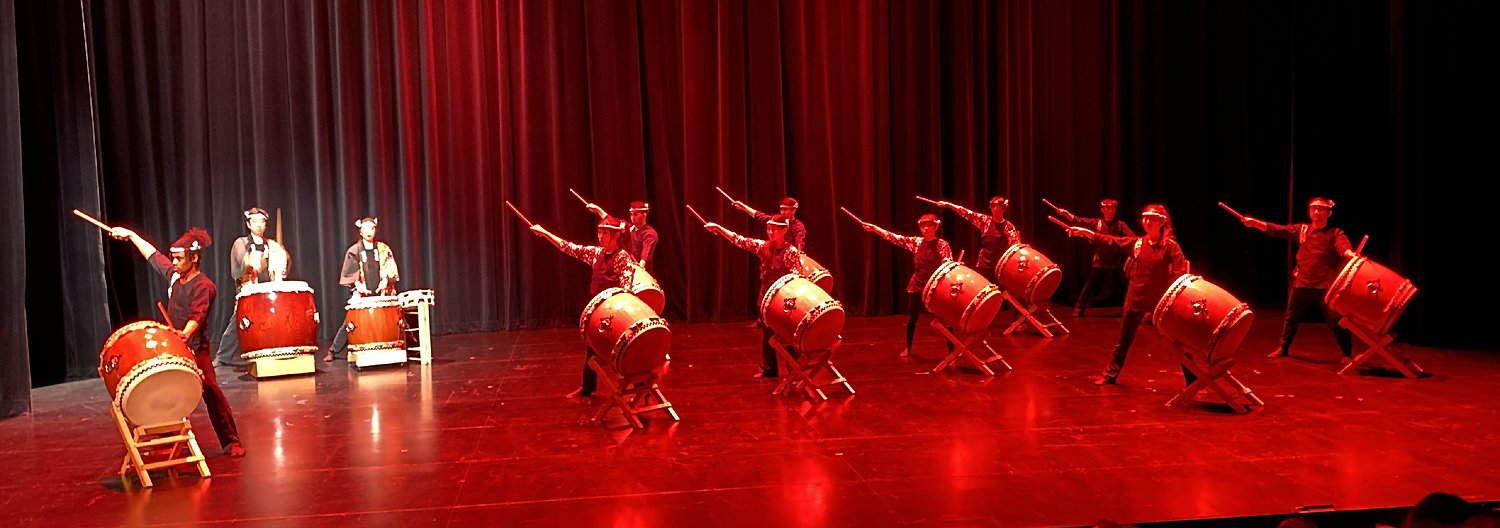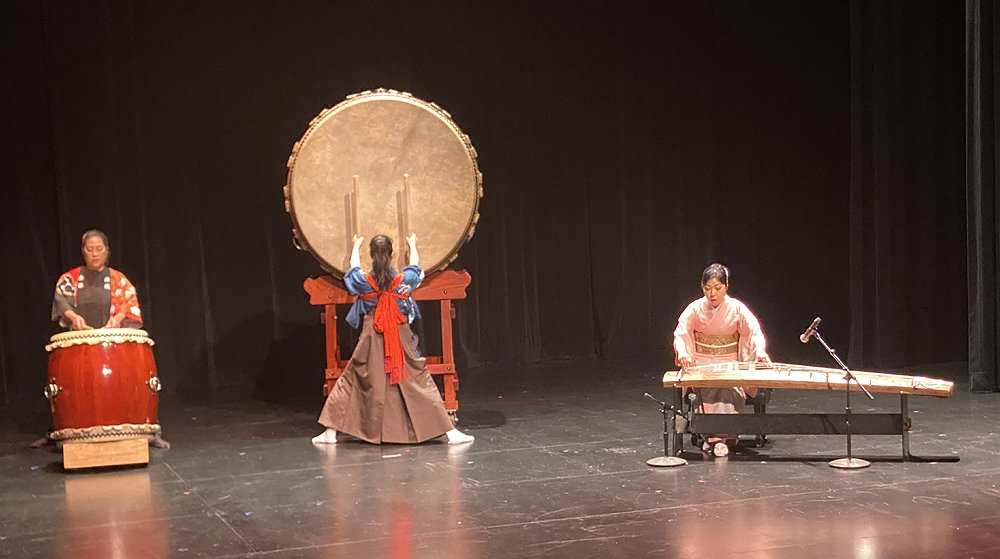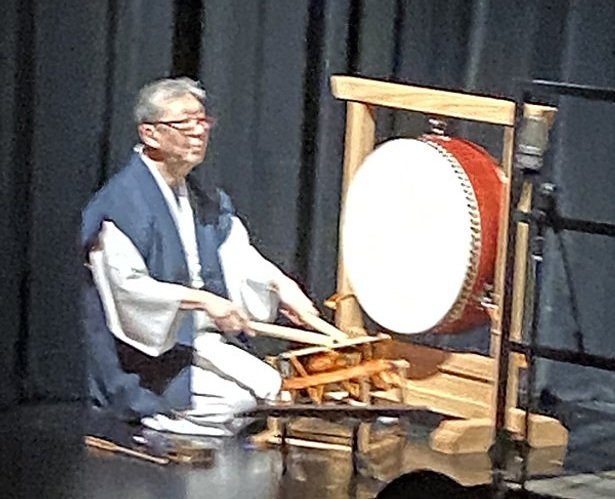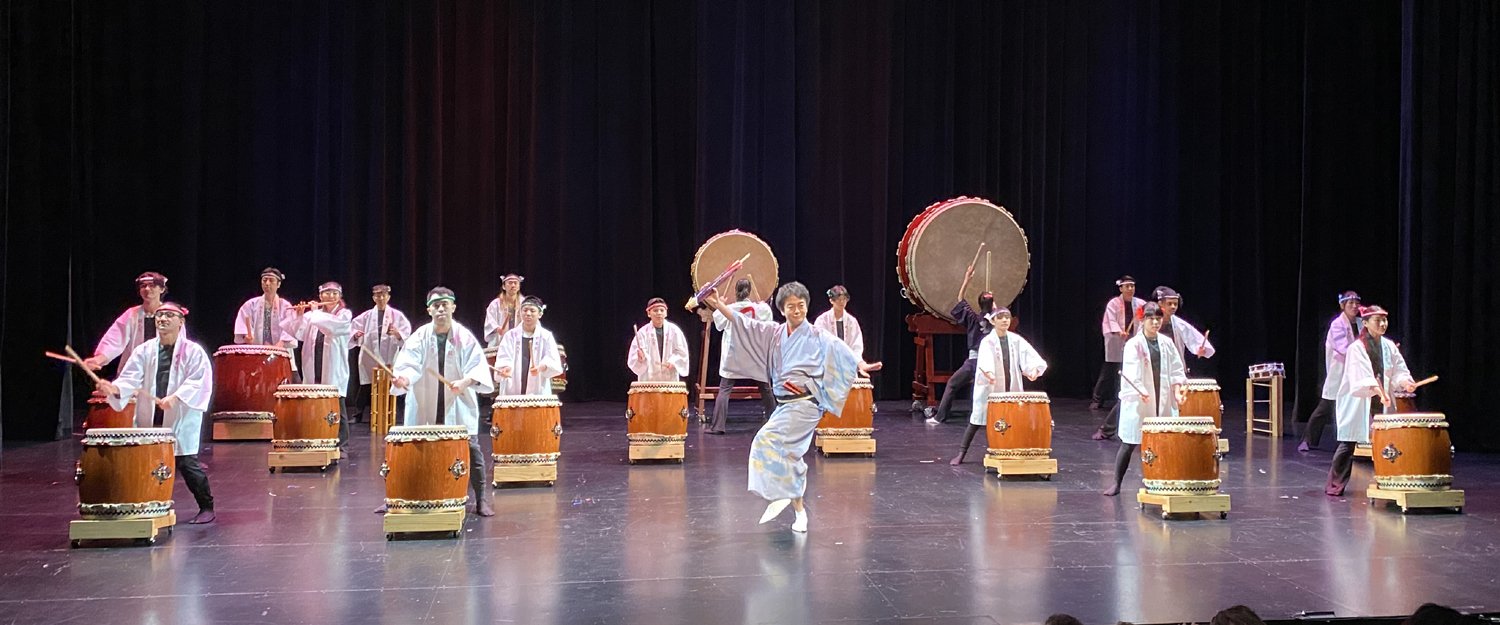Taiko Legacy 20 Celebrates Its Milestone to Bring Theatrical Taiko Arts
Tsukasa Taiko presents its theatrical taiko performance at Taiko Legacy 20
The Taiko Legacy, performed by the Tsukasa Taiko, celebrated its 20th anniversary at the Edlis Neeson Theater of the Museum of Contemporary Art Chicago on December 17, 2023. The Reduction 9, a more experimental music presentation, was also held on December 16 at the same place.
Now the Taiko Legacy 20 has grown to a group of professional performers, who invite national and international musicians and performers, to present a conceptually diverse and dynamic musical performance.
Tsukasa Taiko’s mission is to pursue the creative articulation of taiko and traditional Japanese arts through theatrical expressions that converge traditional with contemporary, and classical with experimental performance. The stage of the Taiko Legacy accentuates the professional acumen of the community ensemble, highlighting the complexity of percussive and choreographic musicality.
The addition of the Reduction program enables the Tsukasa Taiko and Asian Improv aRts Midwest to present more experimental and refined musical stages while maintaining artistic integrity through aesthetic cultural lineage and creative flexibility.
Remarks by Consul General Jun Yanagi
Consul General Jun Yanagi
In his congratulatory remarks, Jun Yanagi, Consul General of Japan in Chicago, applauded Tsukasa Taiko and Asian Improv aRts Midwest for their significant contributions saying, “They are pivotal in showcasing the richness of Japanese arts and culture.”
Consul General Yanagi mentioned AIRMW’s mission which was to build a vital sending power of the Asian American community in the Chicago area by advancing the outstanding profile of the Asian American cultures, and said, “The taiko tradition among Japanese Americans has been indeed played crucial role in making taiko resonate globally.”
He also said that taiko-drumming, which had started with Japanese people, has connected Japanese Americans, Asian Americans, and other various ethnicities through taiko performances. He expressed his gratitude saying, “I appreciate profound cultural connections fostered by the AIRMW and Tsukasa Taiko and hope today’s Taiko Legacy concert continues to resonate and inspire fostering even deeper appreciation for the rich tapestry of the Japanese, Japanese American, and Asian American arts and culture in our communities.”
Stage of the Taiko Legacy 20
Tsukasa Taiko performs Yataibayashi.
The stage of the Taiko Legacy 20 started with a “Yataibayashi.” The unity sound of brisk taiko drums, rimshots, and cheering shouts resonated into the ears of the audience. It was obvious that the members of the Tsukasa Taiko grew up to be professional performers from kids who wanted to enjoy hitting drums 20 years ago. The pieces played to celebrate their 20th anniversary were Okeiko Hachiban, Meishinden, Rokuban, Gintenkagura, Yanagimachi, Izumi Daihachi, and Motone.
Koto Master Reikano Kimura (R) plays Gintenkagura with Kioto Aoki (C) and Melody Takata.
Their guests were Grand Master Chizuru Kineya of Nagauta shamisen; Koto Master Reikano Kimura; Grand Master Hyakkyo Fukuhara of bamboo flute (virtual); Grand Master Yoshinojo Fujima of Shubukai Japanese classic dance; Grand Master Bjo Ageha of Minyo dance, and Melody Takata of the GenRyu Arts Performers in San Francisco.
Between the performances of Taiko Legacy, Chizuru Kineya and Tatsu Aoki made a rare jazz session by shamisen duo. Shamisen is a Japanese traditional three-string-instrument. Yoshinojo Fujima presented a Japanese classic dance, Miyumi Aoki played the bamboo flute, Kineya played a Chicago-only-Nagauta- medley, and Reikano Kimura collaborated with taiko drumming.
Tatsu Aoki, Executive Producer and Artistic Director of the Taiko Legacy, appeared on the stage to greet the audience and said, “We are going to keep going for 30, 40 years,” and looked back at the progress of the taiko drumming and performance.
When Aoki grew up in the 1960s to the late 70s, the popularity of the taiko ensemble also grew among the people both in Japan and North America. Aoki said there were two types of taiko groups, and one was groups of people who were interested in matsuri (festival) taiko and played more athletic-featured taiko drumming.
Another was groups of people who were seeking to reconnect matsuri taiko to the theatrical stage such as kabuki theatre and dance theatre with shamisen music.
Tatsu Aoki who was raised with Japanese traditional music.
Born in a geisha house in Tokyo, Aoki grew up with classic dance, taiko drumming, and shamisen music. Due to his background, Aoki connected himself to the latter.
While the former was developing maturi taiko, Aoki said the latter had a different type of responsibility to develop the aesthetic taiko drumming, not really music in the festival, but on the stage.
“So I really decided to focus on my team in this theatrical presentation for the taiko culture.
It was toward more Japanese music, shamisen music, and classic dance music. So I stayed in that side of the group and studied very, very intensively how this to be musically realized,” Aoki recalled.
Tsukasa Taiko presents Yanagimachi.
One thing Aoki never forgot was his teacher’s words, “Don’t hit the drum, but you hit music.” So he got the idea of hitting music and dancing the drum. Aoki said, “Along the way, we developed this really nice implication of how to dance, how to hit music.” Aoki finally brought a theatrical taiko art and music on the stage of the Taiko Legacy which has advanced for 20 years and continues to years to come.
The finale of the Taiko Legacy 20 was a piece called “Motone” where all the members of the Tsukasa Taiko played taiko drumming, Bijo Ageha danced Japanese folk dance swiftly, powerfully, and gracefully. All the guests and staff went up to the stage one after another. It was really a brillante finale to celebrate the 20 years of advancement.
Tsukasa Taiko plays the final piece Motone, and Grand Minyo Master Bijo Ageha dances a minyo piece from Aomori Prefecture.
Interview with Grand Master Chizuru Kineya
Grand Master Chizuru Kineya and Tatsu Aokii play free jazz which can be rarely seen in Japan.
Grand Master Chizuru Kineya of Nagauta Shamisen made the stage of Taiko Legacy more brilliant with her gorgeous kimono. It was a customized kimono made of silk fabric with handmade swatow embroidery. She tailored it for her special performance occasions and brought it to Chicago. “Today is the 20th anniversary of the Taiko Legacy, so I wanted to help make it a bit brighter with this kimono,” said Kineya, who has watched over the Tsukasa Taiko for so many years, and her words expressed her affection for the taiko group.
Q: What do you think about today’s celebration?
Kineya: When I first met Kioto, daughter of Tatsu Aoki, she was a little girl in grade school. But now she leads Tsukasa Taiko and has become a really strong supporter of Tatsu san. Kioto grew up to take a strong leadership during those years, so I feel the Tsukasa Taiko will be in good hands. That is my first impression after seeing today’s Taiko Legacy.
Q: What was the name of the shamisen duo that you played with Tatsu san?
Kineya: It was a free jazz shamisen played by improvisation. If I give it a name, it would be “Today’s Feeling.”
It was a jazz and classic collaboration, and there was no rule between Tatsu san and me. Anyway, we had to continue to play until the next stage was ready to go. Probably you cannot see this kind of free jazz shamisen in Japan.
Q: Another time, you played solo shamisen. Was that Nagauta music?
Kineya: It was a medley of typical Nagauta pieces which I picked no lyric parts and combined them as a medley. I think some audiences could recognize famous Nagauta pieces such as Miyakodori and Ume no Sakae.
There is one rule in Japan that Nagauta should be played by plural players because it is brilliant theater music. But here is America, so I played it by myself, and I think you could enjoy hearing my solo sounds.
Q: Could you tell us about your recent activities?
Kineya: We had a long pause due to the COVID-19 pandemic, but now we started restaurant lives and dinner shows in Tokyo. Please come to see me at my live concerts.
Q: Thank you very much for using your busy time just after the stage.
Taiko Legacy 20
Tatsu Aoki’s Journey to Bring Theatrical Taiko Arts to the Stage
After the state of the Taiko Legacy, Tatsu Aoki said, “When I look back at the 20 years of Taiko Legacy, so many things have happened, but present members of the Tsukasa Taiko, members who had left, and guest artists, we all built the 20 years of our history together, so I’m very pleased to celebrate the 20th anniversary of Taiko Legacy. We also opened our own dojo in the same year, we carried our taiko and instruments out to the MCA and brought them back to our dojo for the first time, so everyone felt the actual sensation that we made the 20th Taiko Legacy together. I’m pleased to see that each member left his/her traces on the stage and that they continue to this day.”
Q: At the opening piece of Yataibayashi, the performers were in perfect sync with each other. I thought it was because everyone was united in spirit.
Aoki: They have solidarity because they have been working together for many years, and each member has pride in the Tsukasa Taiko. It can be an ownership of Tsukasa which they feel. I was impressed by that and thought their sense of ownership would be the spirit of Tsukasa Taiko from now on.
Q: I felt the spirit of all the members who wanted to give the best performance.
Aoki: I think everyone really felt the same way. In the early days of Taiko Legacy, I don't think they realized what great things they were doing.
I had come to believe that taiko performance as a theatrical art, which I had been doing since the '70s, was the best form of community taiko, and I knew how great it was, but everyone was still very young at the time. Now, when I show them the big line, they can perform well without me having to say anything, and with the pride they have in themselves. This time I really felt that my passion for the theatrical arts is working outside of our hands.
Now that the dojo has been established, the next generation must do this. They have all been working together to get to the performance by ourselves, and I think the stage of the Taiko Legacy really showed that.
Q: Could you explain the words of Tatsu-san's teacher, "Dancing the taiko and hitting the music," a little more?
Aoki: "To hit the taiko is to have a festival and beat it. If you take it to a stage where there is no festival, you have to dance the taiko and hit the music. That's what I was told, and that has been my philosophy for a long time.
So the combination with the Fujima School Shubukai and with the traditional Japanese musicians is like a replica of what I was doing in Japan, and I think that everyone in the Tsukasa Taiko understood that.
My way is to do theatrical performing arts, so I have independent shamisen showcases and the koto performance with singing, and I do not use the shamisen as an accompaniment to the drums or anything like that. This way of presentation is an element that would never come up unless you know the Japanese traditional performing arts, and my idea of Tsukasa Taiko is to bring all of these elements. That's why I thought we needed a dojo where we could practice taiko, shamisen, and dance, and finally, after 25 years, we were able to do that.
Q: So the Taiko Legacy is the embodiment of Tatsu-san's vision of the theatrical performing arts?
Aoki: That's right. I believe in an artistic style, an aesthetic art, and I have my own pride in the art of taiko in the community. And the fact that everyone is taking pride in it is really a result of everyone's help. I think the joy of celebrating the 20th anniversary of the Taiko Legacy was truly amazing.
This time, the most important thing for me is the generational shift after we have all done together. I feel that it has been completed in my mind. I think that the next generation will be able to continue Tsukasa Taiko in their own way.
Q: What is next for you, Tatsu san?
Aoki: My next mission is to set up a system to run this dojo properly. We have taiko, dance, and shamisen here, and of course, we do contemporary things, and I also do my own artistic and musical activities. But the biggest thing is to run this building. I want to make sure that the system will work properly, and I want to give it to the next generation.
Q: The performance by Tsukasa’s members really exuded the theatrical performing arts that Tatsu san had aimed.
Aoki: I am so happy that hundreds of people understand us in that way.
I’m very grateful to all of the people for helping us celebrate this 20th anniversary. Playing taiko ensemble is not a one-person show, and I really appreciate the performers, the backstage crew, the volunteers who support us, and all the people who work together to put on such a great show. I am sure that everyone is very grateful for all the work that was put into this event. This time, it was indeed a Taiko Legacy of gratitude.
Q: Thank you very much.
Tatsu Aoki (L) thanks the performers, staff members, and volunteer supporters for their tireless support.









